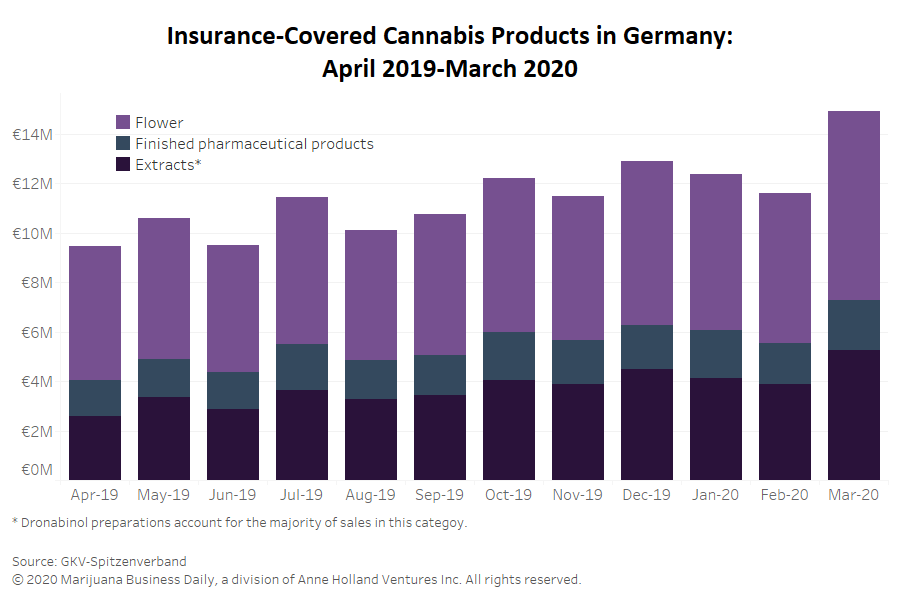[ad_1]

Insurance reimbursements for medical cannabis in Germany continue to reach fresh quarterly records, according to new data for the January-March period.
In the first quarter of 2020, total reimbursement of cannabis and marijuana-related medicines reached 38.9 million euros ($43.7 million), the German National Association of Statutory Health Insurance Funds (GKV-Spitzenverband) reported.
That is 6% higher than the final quarter of 2019 and 58% more than the first quarter of 2019.
German pharmacies processed 78,233 prescriptions under the statutory program in the first quarter of 2020, up 6% from the previous quarter, indicating that the average cost per prescription remained largely unchanged at almost 500 euros.
All cannabis and marijuana-related products are included in the data, from unprocessed flower to finished pharmaceutical products such as Sativex.
March was the biggest month since the current regulatory framework was implemented in early 2017, with total reimbursements reaching almost 15 million euros.
The previous record came in December 2019 with almost 13 million euros reimbursed.
Sales in January and February 2020 were about 12 million euros each month.
A possible explanation for the March 2020 spike could be that patients stockpiled medicine due to COVID-19 fears.
Market size grows
All reimbursement data is based on retail prices at pharmacies, which are the only authorized points of sale to patients in Germany.
For products not included in the “finished pharmaceutical products” category, pharmacies used to mark up prices as much as 100%.
But that changed retroactive to March 2020, with margins likely compressed across the supply chain.
Reimbursement data does not include private prescription sales, which are paid out of pocket by patients.
Because reimbursement data doesn’t include those payments, the total sum covered by statutory health insurers should not be considered as the total market size.
The German government acknowledged earlier this year that it does not know how much cannabis was sold in Germany in 2019 because it has no data about private prescriptions.
That is in contrast to markets such as Canada and Denmark, which track and release much more data than Germany.
Marijuana Business Daily‘s recent report, “Medical Cannabis in Europe,” estimated the total sales in the German market in 2019 amounted to at least 170 million euros.
That includes 123 million euros that were covered by statutory health insurers and about 50 million euros of estimated sales paid by patients out of pocket.
Product mix
Flower – which includes the categories “unprocessed flower” and “flower used in preparations,” typically sold as ground flower – accounts for slightly more than half the total insurance-covered cannabis market.
It represented 51% of total reimbursements during the first quarter of 2020, unchanged from the previous quarter.
Also unchanged was the percentage of extracts sold as magistral preparations, which remained at 34% of total reimbursements.
Within the extracts category, the majority of the sales are represented by pure THC preparations – sold to pharmacies as dronabinol API – but also included are some pharmaceutical CBD sales as well as full-spectrum extracts.
Canopy Growth produces most of the dronabinol sold in Germany, most of it plant-derived.
A new supplier of dronabinol became available to pharmacies in April, offering plant-derived THC imported from Israel.
Finished pharmaceutical products, a category represented mostly by Sativex, represented 15% of the reimbursed market during the first quarter of 2020, the same as the previous quarter.
The exporters
Germany continues to be the largest importer of medical cannabis in the world with its own domestic flower production not expected to reach the shelves until the last quarter of this year.
At least through the end of 2019, all flower and full-spectrum extracts reimbursed was imported either from Canada, the Netherlands or Portugal.
MJBizDaily‘s European medical cannabis report estimated that in 2019 Germany imported 54% of its flower for pharmacy dispensing from Canada, 38% from the Netherlands and 8% from Portugal.
Growth of reimbursements in Germany in the first quarter of 2020 was in line with the international medical revenue growth reported by Aurora Cannabis, Canopy Growth and Tilray for the same period.
Although Canada exports to about a dozen countries, almost all the flower exported is shipped to Germany and the vast majority of the oils to Australia. Exports to other countries are relatively insignificant.
The three Canadian producers with the largest international medical cannabis revenue increased their quarter-over-quarter revenue for their global products in early 2020 but showed mixed results over the past six months.
- Canopy’s international medical cannabis revenue reached 20.7 million Canadian dollars ($15.2 million) in its latest quarter.
- Tilray recorded US$5.8 million, up from the previous quarter but about the same as the quarter ending Sept. 30, 2019.
- Aurora earned CA$4 million, also more than the previous quarter but less than the quarter ending Sept. 30, 2019.
Canopy’s international revenue, significantly higher than its peers, is likely explained by its sales of dronabinol.
Alfredo Pascual can be reached at [email protected]
[ad_2]
Source link







































